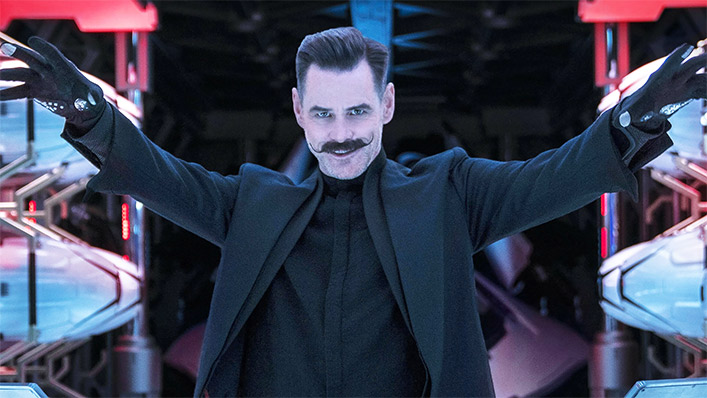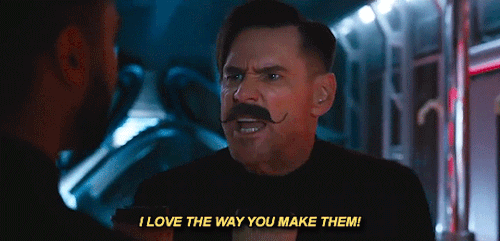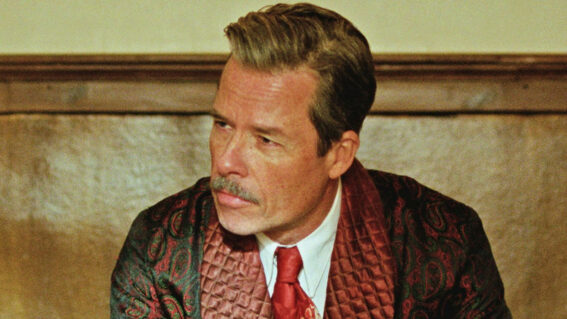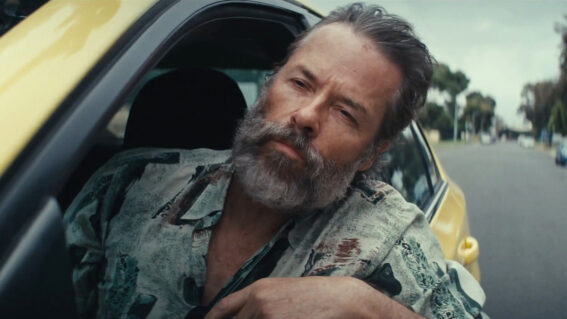Sonic the Hedgehog will make you nostalgic for Jim Carrey, not 90s video games

The protagonist of Sonic the Hedgehog is an annoying computer-generated blue fur ball. Jim Carrey however brings the film to life in a way that makes us pine for the good old days of the comedian’s career, writes critic Luke Buckmaster.
It should have been a super villain origins movie, and it should have been called Dr Robotnik. Not all that long ago such a proposition would have been absurd: to focus a Sonic the Hedgehog movie not on Sega’s spiky blue speed demon, but on his nemesis – a maniacal techhead commanding an army of drones, like Mysterio from Spider-Man: Far From Home.
In the present moment however it isn’t absurd at all: not in the afterglow of this year’s Oscars, during which a Batman-less Joker movie led the field with 11 nominations. There are other examples of supervillains going mainstream, such as the lucrative Despicable Me movies – about a scarf-wearing snob who wants to steal the moon – and the more adult Birds of Prey, starring Margot Robbie as a former psychiatrist who, erm, changed career tact to become a baseball bat-wielding sadist.
Centering the film on Robotnik would have meant focusing more on Jim Carrey’s performance, which evokes 90s nostalgia more powerfully than any vision of an extraterrestrial hedgehog running around in circles. And I don’t mean nostalgic for Sonic; I mean nostalgic for Carrey’s heyday – when the lanky star’s elastic antics were in full flight in comedies such as Ace Ventura, The Mask, The Cable Guy and Liar Liar.
The Sonic movie is very good – snappy, fast-paced and visually interesting – up until the point the very stir fryable protagonist begins speaking. This unfortunately occurs approximately 15 seconds into the running time. Director Jeff Fowler screeches Sonic to a halt, deploying a freeze frame during which the character delivers hackneyed voice-over narration, which peaks in cringe-worthiness with the line “I’ve been running all my life.”
Sonic is hiding in the small town of Green Hills, Montana, where he is bored, frustrated, lonely and prone to bouts of whining. This place accommodates – as every small American town does or should, according to knowledge I have drawn from the movies – a bushy-bearded crazy man who nobody listens to but is completely right about the extraterrestrial living among us. After Sonic accidentally calls attention to himself by creating a massive power surge, the government calls in Dr Robotnik to take care of the situation, which basically means euthanizing the hedgehog – or at the very least putting him in a cage and prodding him with sharp instruments.
Sonic springs to life when Jim Carrey arrives on the scene
When Carrey first appears, descending with his twirly mustache and long black coat from a bus-like mobile villain lair, the film instantly improves. His ridiculous opening monologue – delivered in the old school, idiosyncratic Carrey style, with rubbery countenance and odd points of vocal emphasis – has Robotnik intimidating a military man, stating in clear terms who is now in control and professing his love for machines (because they obey orders). It is clear from this early moment that Carrey will extend the reality of the film, moving it into the realm of cartoon much more than the actual cartoon elements themselves, i.e. the computer-generated Sonic.
Fowler and his screenwriters (Patrick Casey and Josh Miller) routinely have the protagonist breaking the ‘show don’t tell’ dictum. “Oh no! They’re outside! I better go!” that glossy blue materialisation of dopey writing squeaks at one point, reading a bit in the script marked with highlighter pen. Imagine, I thought when watching this sorry sequence, if Sonic never spoke in this movie. Imagine how much harder the writers would have had to work.
Imagine also, for that matter, if Jim Carrey didn’t speak either. Not in this film but throughout his entire career. I certainly have. I used to believe – and occasionally comment – that Carrey would have made a great silent film star, for th eobvious reasons: i.e. his over-the-top magnetism and his extreme physicality.
Now I’m not so sure. Carrey’s OTT style might have suited the OTT style of the time, becoming melodramatic in the accepted and ubiquitous way – meaning he might have slipped into a film rather than stood out. It doesn’t take much imagination, for instance, to imagine Carrey in the lead role in the great 1928 silent drama The Man Who Laughs, led by an unforgettably histrionic performance from Conrad Veidt as the humiliated star of a travelling carnival.
Back then cinema wasn’t obsessed with realism like it is now. Contemporary movies like Sonic embrace wacky concepts not for their imaginative possibilities, but for the opportunity to take something fantastical and otherworldly then integrate it into our own universe, transforming the magical into the mundane (there are some exceptions, such as the fabulous Spider-Man: Into the Spider-Verse, which used zany storylines to inspire zany aesthetic: an example of content influencing form).
Carrey’s OTT performance pushes the film away from realism
Carrey’s performance in Sonic isn’t the glue binding the film together – the CGI furball and his human pal (James Marsden) fill that role – but the glitter that sprinkles it with colour and life. He pushes the experience away from realism, which it should never have been (hedge)hog-tied to in the first place.
In one brief but fun moment, Robotnik is dancing in his villain-lair-on-wheels when is interrupted by his right hand man, who offers him a coffee. Robotnik responds: “Of course I want a latte, I love the way you make them.” A normal line, right? Nothing special about it.
Carrey however bellows out the second half of it, screaming maniacally at the top of his lungs. A simple “I love the way you make them” becomes a wall-rating “I LLOVVEEE THE WAY YOU MAKE THEM!” He says this in a manner impossible to describe in words, but instantly familiar to anybody who’s seen a Jim Carrey movie from the 90s. Speaking like this used to be par for the course for him, before he made his journey into a generally less theatrical performance style.

It’s a funny moment, the joke arising entirely from the inappropriateness of Carrey’s intonation. It doesn’t make sense for him to deliver the line in that way. This sort of wildly unhinged interpretation of simple dialogue is reminiscent of the work of Nicolas Cage, whose many comparable moments often carry extra oomph, because they regularly exist in the realm of drama rather than comedy. Or, as in here, a hammy villainous performance with gadgets, yelling, SFX and scenery chewing.
Here’s an idea: how about somebody makes a hard-hitting drama co-starring Carrey and Cage, featuring both actors in overtly melodramatic mode? Now that I would pay to see. But for now, in the canon of Carrey, we have to settle for the crumbs of craziness dished up in Sonic. Or perhaps we can rewind to the good old times and delve into those 90s classics.


















